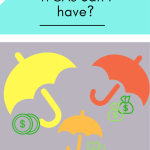We all know how I feel about the TFSA — using it as a savings account is pointless, and the real magic only happens when you invest within it. But so many Canadians have literally no idea how to start investing! They think the only option is to walk into their bank and make a meeting with a financial advisor and buy what he tells them.
That’s the worst move ever. Anyone who works for a bank and calls themselves a financial advisor is a liar. They are salespeople. They make commission off selling you financial products they create. They’re not working for you or your financial goals, they’re working for your bank.
Other horrible investment ideas are GICs. In this low-interest environment some GIC rates are lower than high interest savings account rates! To get ahead you’re going to need to invest.
But how? Literally, how, you ask? Easy. Simply go online…you’re online right now so open a new tab and sign up online for a TFSA account. Then mail them a cheque (some offer this service electronically). Once they’ve linked your chequings account you can transfer money in and out and buy some investments.
3 best options to start investing in your TFSA:
- WealthSimple: Buy a model portfolio at this robo-advisory
- Tangerine: Buy an index-mutual-fund
- Questrade: Choose your own ETF mix at this discount brokerage
All of these options make it SO easy to invest. Their websites are intuitive and their products conservative. It takes no more than a few clicks, a stamp, a cheque and an envelope to start. So please do! In fact, you can skip the rest of this blog post and go to any of those websites and just start.
But in case you want to learn more, let’s go through each of these options to figure out which is the best for you.
What are you investing for?
If your goals are short and medium-term, like a house purchase, a vacation or grad school, it’s better to simply park your money where you can’t lose it: in a high-interest savings account earning at least inflation (currently 1.7%). If you happen to have room in your TFSA for this, it’s alright to stash it there as at least you’ll be saving a few dollars on taxes. But try to save as much room in your TFSA as you can for long-term goals, such as retirement.
When you save for a long-term goal it’s FAR easier to invest since you can ride out the waves of the market and choose less volatile investments. When you’re trying to make money quick you’re more likely to be speculating aka gambling rather than investing. So choose a goal that’s at least 15 years in the future. The best thing about the TFSA, unlike an RRSP, though is that you can take that money out if you find you need it sooner.
What’s your risk tolerance?
Figuring out your risk tolerance is essential to helping you pick appropriate investments. If you’re 40 with children and a mortgage your risk tolerance is going to be lower than a single 25 year-old. Your personal comfort level with investments also plays a part. If the market tanks and you get nervous and sell your stock, than you need to be buying mostly fixed-income investments. In contrast, if you have nerves of steel and never check your balance, then you can put up to 90% of your portfolio in stocks.
The only way you can make money off investments is by buying low and selling high. So you either need to time the market (impossible and speculative) OR you need to buy and hold investments secure in the knowledge that markets will rise and fall over time, but any fall is temporary and markets will rise over the long-term. The closer you get to your goal, the more conservative you can make your portfolio to minimize loss.
Don’t overthink investing
Long-term buy-and-hold investing is not hard. All it requires is commitment and access to a computer. The truth is, you can always find a better return somewhere. But if that’s your goal you’re going to need to spend hours and hours looking through financial statemtents and educating yourself (and you still may come up short). Instead, pick a strategy and never waver. Let the “market” go up and down and let your cousin’s brother in-law make 35% off a penny stock and you just stare straight ahead and tune out the noise.
What you really need to do is have a “good-enough” attitude. If you’re making between a 4%-10% return (depending on your asset-class mix) you’re already doing better than 99% of the population and are likely on track to support your dreams. If you start trying to keep with people making 25% on the market, that’s where you’re going to get into trouble and start speculating. Ignore all hot tips. Stick with tried and true methods: buying broad-market ETFs, contributing regularly and rebalancing infrequently. It’s like baking a cake: once you mix in the ingredients, don’t open the oven door or the whole thing will fall.
Creating a portfolio asset class mix
There are two main type of investments: ETF bonds and ETF stocks, sometimes called fixed-income and equities, respectively, because the financial sector likes to make things confusing. There are also additional asset classes like commodities and real estate, but we’re keeping things simple here. The portion of your portfolio you decide to put into each asset class should reflect your risk tolerance.
So for our high-risk folks, 90% equity ETFs and 10% fixed-income ETFs would work well. For our lower risk folks, 50%/50% stocks would better.
Every year or so re-balance your portfolio. That means if your equity ETFs have exceeded 90% of your portfolio because they are doing so well, you sell some of them off and buy more fixed-income ETFs. If your fixed-income ETFs are doing well and have exceeded 10% of your portfolio, you sell some of those off and buy more equity ETFs. This protects you from huge market crashes.
Does this sound confusing? Don’t worry. We now have algorithms who can do this all for you.
Automated portfolios
If you decide to automate your investing, through a robo-advisory (WealthSimple) or index mutual-fund (Tangerine) than you never have to worry about anything.
Robo-advisories and index-mutual funds work because they buy ETFs across different asset classes and automatically rebalance them.
You simply open an account an choose an appropriate risk tolerance. They make all the decisions for you. The fee they charge for this is usually around .05-1%.
This is by far the easiest way for the average person to invest. In fact, it almost sounds too easy! That’s because people like to make things difficult for themselves with stock-picking and timing the market.
But wait…WTFs an ETF?
I’m going to copy the Canadian Couch Potato’s explanation of ETFs and index mutual funds because I think he says it best:
“What’s an index mutual fund?
First it’s important to understand what an index is: it’s a group of stocks or bonds used to measure the performance of a particular market. For instance, the S&P/TSX Composite includes about 250 companies traded on the Toronto Stock Exchange, and it’s considered a barometer of the entire Canadian stock market.
Similarly, the S&P 500 and the Russell 3000 are two of the many indexes that measure the US stock market. The MSCI EAFE is a popular index of international stocks. Other indexes track the fixed-income market, such as the widely used DEX Universe Bond Index, which covers both government and corporate bonds in Canada.
An index mutual fund holds all (or almost all) of the stocks or bonds in a particular index. The idea is to produce a return extremely close to that of the overall market. That’s different from the goal of “actively managed” mutual funds, which try (usually unsuccessfully) to choose individual securities that will outperform the market. To use a favourite phrase of John Bogle, the father of index investing, instead of looking for the needle in the haystack, index funds just buy the haystack.
What are exchange-traded funds (ETFs)?
Exchange-traded funds, or ETFs, are similar to index mutual funds in that they hold a portfolio of stocks or bonds and track a specific index. However, unlike mutual funds, ETFs are bought and sold on an exchange, like stocks.
While investors usually pay a commission to buy and sell them (just as they would when trading stocks), ETFs typically have lower annual fees than index mutual funds. There is also a much wider selection, offering investors access to almost every kind of asset: stocks, bonds, real estate, commodities, precious metals, currencies and more.”
If you decide to go this automated route, the two best options in Canada, in my non-sponsored opinion, are the following:
WealthSimple has an amazing website and a lot of education on ETFs. The first $5,000 is managed for free but you can easily get a promo code to get the first $10, 000 managed for free. (FUN FACT: I went to elementary school with its founder, Michael Katchen) and it embarrasses me how successful he is. He is also not paying me for this post. Unfortunately).
Tangerine makes it SUPER easy for you to invest within a TFSA especially if you’re already an account holder. They offer 4 or 5 funds appropriate for every risk tolerance. Just pick one and sit easy for the next 30 years. The Canadian Couch Potato himself recommends this funds in his model portfolio, so that’s a huge vote of confidence.
Creating your own ETF portfolio
Some of us would rather save the fee from automated portfolios. Although the fee is nominal, it’s so easy to create your own ETF portfolio so why not? All you do is pick an asset-class mix you’re comfortable with and buy some ETFs! (Literally, click “Buy” and type in the ETF code). Then once a year, rebalance your portfolio.
But how do I pick an asset class and which ETFs, you say? Not to worry, we have people far smarter than us on the internet who have done all the work for us!
The Canadian Couch Potato has a cheat-sheet on appropriate asset class mixes and specific ETFs to purchase.
It’s that easy! Just create an account at Questrade (my preferred discount brokerage) and ETFS are FREE to purchase (no commission!).
Investing is easy
Seriously, people make investing so complicated and it’s really not. Anyone can do it. It’s never been more accessible to buy. You don’t need to know ANYTHING about stocks or the market. Let robo-advisories, index-mutual funds and the Canadian Couch Potato’s cheat sheet do it for you! So start early, contribute often and never try to beat the market.
*Disclaimer: This investing advice is all my opinion. I am not a professional investment advisor.










There is 1 comment
[…] you purchasing? Bonds or GICs? Are you investing in equities like stocks or ETFs? (Here’s 3 easy TFSA investment ideas to help you […]